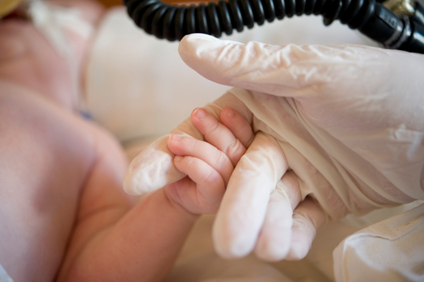I received the following email from Susan O’Connor, a Board Certified Neonatal Nurse Practitioner and Neonatal Resuscitation Program (NRP) instructor:
I see so many comments about midwives being “trained” in NRP, but people not realizing that without the equipment necessary (ETT, bag/mask, oxygen, epinephrine, umbilical lines, saline, etc) you are not performing NRP. NRP is so much more than just the rate of compressions to breaths; … taking a class in NRP [does not mean] that a midwife is actually qualified to resuscitate a baby. And performing NRP correctly can make the difference between life and death in a neonate.
I invited her to share her thoughts and experience with you in the guest post below:
Neonatal Resuscitation Program (NRP) is a specialized type of resuscitation that was designed for neonates and their unique physiology and needs after birth. The American Academy of Pediatrics in a statement May 1, 2013 affirmed “there should be at least 1 person present at every delivery whose primary responsibility is the care of the newborn infant”. This is in addition to the midwife who is attending to the mother, in the situation that both the mother and infant need simultaneous resuscitation.
Many midwives – especially lay midwives – will claim they are trained in NRP and able to provide resuscitation to a newborn. Unfortunately, taking a class in NRP does not mean anything when it comes to the actual resuscitation of the infant. NRP is a systematic method of evaluating and providing support to a struggling neonate, which includes advanced life support.
NRP is set up in 30 second intervals: you have thirty seconds to determine whether your interventions are working and if they aren’t, to escalate care.
First you provide positive pressure ventilation with a bag/mask.
If that is not working, you must intubate the child to provide a secure airway – the first thing that most midwives cannot do. Intubation is not a skill you can perform infrequently and expect to be successful, especially in a stressful situations.
Once you are providing respiratory support, if the heartrate is still low (below 60) – compressions must be started.
But giving compressions in coordination with ventilation isn’t enough. At the point where you are doing this, epinephrine should be drawn up. It can be given through the breathing tube, but the most effective way is through the umbilical vessels. This is the next step in NRP that lay midwives cannot provide. They cannot have epinephrine for the infant, and they definitely do not have the equipment and training to place an umbilical line.
In a code situation, volume expansion [fluid] is frequently needed. Normal saline should be infused through the umbilical line, in order to be able to support circulation.
Occasionally, even other interventions are necessary, such as administration of surfactant, or the child could have a pneumothorax, a leak of air from the lungs into the chest and prevents infants from being able to breath/beat their heart well. In a hospital setting, you have all those supplies and trained personnel to be able to stick a needle into the chest to release the air. Some infants develop a pneumothorax spontaneously, without any risk factors or obvious cause.
All of these things happen in 30 second intervals. That means by 2 minutes of life if the baby is depressed, you are giving epinephrine and putting in lines while giving adequate ventilation. That’s a very short time-frame. It takes confidence, repetition and study to be able to provide adequate resuscitation to a newborn. Midwives are trained in the care of the mother and basic well-baby care. In the hospital, OBs do not provide NRP; typically, it is specialized nurses, nurse practitioners and physicians who do it.
This lack of ability to provide true neonatal resuscitation accounts for some of the morbidity and mortality that is seen with home births.
Bad things can happen at home and in the hospital, but in the hospital, you have a team of highly trained individuals who are dedicated solely to saving the baby’s life. That’s a huge departure from the care provided by midwives and that alone should explain why births are safer in the hospital.


